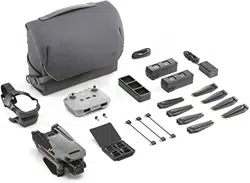Loading ...
Loading ...
Loading ...

DJI Mavic 3
User Manual
19
©
2021 DJI All Rights Reserved.
If the RTH is triggered through DJI Fly and the aircraft is farther than 5 m from the Home Point, a
controller signal is restored.
When the lighting is not sufficient and the vision systems are not available, the aircraft will enter Original
Route RTH.
Original Route RTH Procedure:
1.
The aircraft brakes and hover in place.
2. a. If the aircraft is farther than 50 m from the Home Point, the aircraft adjust its orientation and flies
backwards for 50 m on its original flight route before entering Straight Line RTH.
b. If the aircraft is farther than 5 m but less than 50 m from the Home Point, it enters Straight Line
RTH.
c. The aircraft lands immediately if it is less than 5 m from the Home Point when RTH begins.
3.
The aircraft lands and the motors stop after reaching the Home Point.
The aircraft will enter or remain in Straight Line RTH even if the remote controller signal is restored during
Original Route RTH.
prompt will appear in the app to select a landing option.
The aircraft may not be able to return to the Home Point normally if the GNSS signal is weak or
unavailable. The aircraft may enter ATTI mode if the GNSS signal becomes weak or unavailable after
entering Failsafe RTH. The aircraft will hover in place for a while before landing.
It is important to set a suitable RTH altitude before each flight. Launch DJI Fly and set the RTH
altitude. The default RTH altitude is 100 m.
The aircraft cannot avoid obstacles during Failsafe RTH if the vision systems are unavailable.
GEO zones may affect the RTH. Avoid flying near GEO zones.
The aircraft may not be able to return to a Home Point when the wind speed is too high. Fly with caution.
Be aware of small or fine objects (such as tree branches or power lines) or transparent objects (such
as water or glass) during RTH. Exit RTH and control the aircraft manually in an emergency.
RTH may not be available in some environments even if the vision systems are working. The aircraft
will exit RTH in such cases.
Landing Protection
Landing Protection will activate during Smart RTH. When aircraft begins landing, Landing Protection is
enabled.
1.
During Landing Protection, the aircraft will automatically detect and carefully land on suitable ground.
2.
If the ground is determined unsuitable for landing, the aircraft will hover and wait for pilot
confirmation.
3.
If Landing Protection is not operational, DJI Fly will display a landing prompt when the aircraft
descends below 0.5 m. Pull down on the throttle stick or use the auto landing slider to land.
Precision Landing
The aircraft automatically scans and attempts to match the terrain features below during RTH. The
aircraft will land when the current terrain matches the Home Point. A prompt will appear in DJI Fly if the
terrain match fails.
Loading ...
Loading ...
Loading ...
